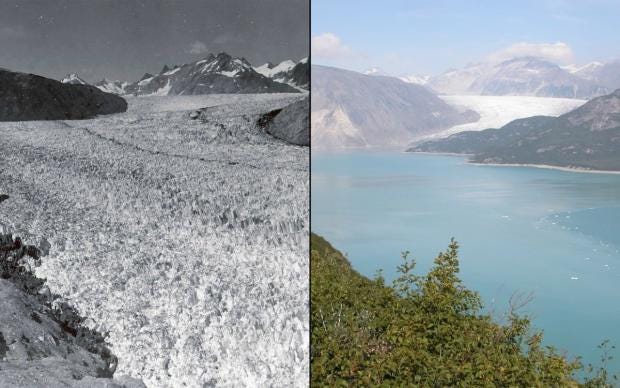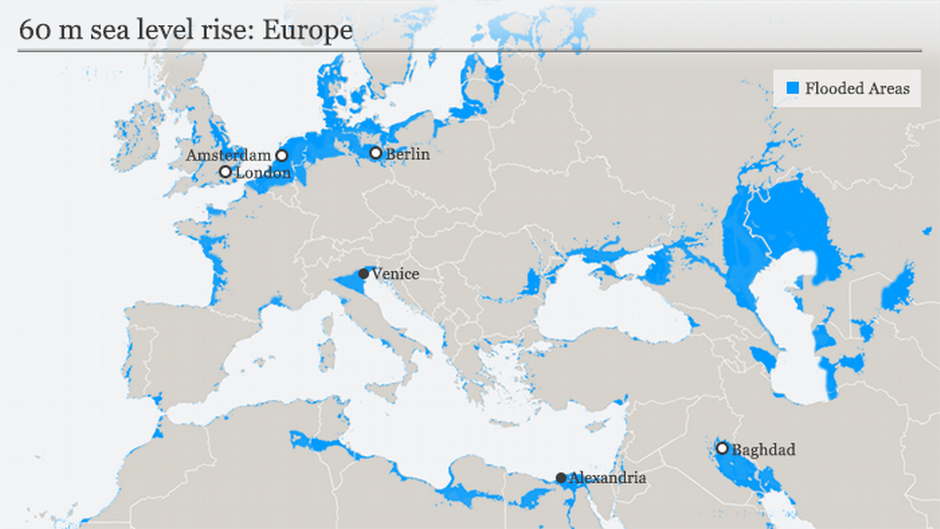Melting glaciers are shifting sea levels— putting the Earth’s coastlines in danger.
In recent decades, global glacier depletion has become a ‘hot topic’. The world watches as age-old ice bodies are quickly melting away at record speed, due to human-induced climate change, and leaving behind dramatic changes to mountain landscapes, freshwater scarcity and significantly rising sea levels around the globe (Rasul, Dahe and Chaudhry, 2008). The implications of these melting glaciers are increasingly impending and predicted to have widespread and catastrophic consequences (National Geographic, 2019).
Whilst seasonal glacier melts are normal to an extent around the world, increasing temperatures has led to prolonged summer glacier melting and a lessening in snowfall during winter (National Geographic, 2019). A recent study conducted by Vargo et al. (2020) assessing the annual glacier melts from New Zealand’s Southern Alps found that the annual melts of these glaciers in 2018 was 10 times more likely to have occurred due to human-induced climate change. The severe increase in likelihood is driven by present-day temperatures rising 1 °C above the pre-industrial average (Vargo et al., 2020). This study confirms that there is a direct connection between human-induced climate change and an increase in annual glacier loss, suggesting that global glaciers will significantly disappear with the intensification of heat events in the coming decades (Vargo et al., 2020).

Figure 1: Muir Glacier, Alaska. August 13, 1941 (Left) and August 31, 2004 (NASA, 2020).
These observations are occurring all over the globe. The Himalayan glaciers are diminishing at rates of 10 to 60 m every year, while many smaller glaciers in the area have already disappeared (Bajracharya, Mool and Shrestha, 2008). Monitoring glaciers in the Cordillera Blanca, Peru has revealed a significant increase in the acceleration of glacier loss over the last 50 years (Pouyaud et al., 2005). On the Antarctic Peninsula and surrounding islands, 87 % of glacier fronts have increasingly retreated south over the past 61 years (Cook et al., 2005). These are just the glaciers in areas being monitored and studied by scientists, consider how many forgotten and overlooked regions that are not being accounted for in the damage.
Rising sea levels
All that water that has melted is quickly traveling down mountainsides, forming creeks, and joining rivers that all lead to the same place: The ocean. Typically in winter, water would be removed from the sea by evaporation to form snow that replenishes the cycle and balances out the melting process (National Geographic, 2019). However, the increase in melting and decrease in snow seasons has created an imbalance between the runoff entering the ocean and the evaporation rates, causing sea levels to rise globally. Massive ice sheets that cover Greenland and Antarctica are also on the move with rising temperatures, and likewise, their meltwater is heading straight for the sea at rapid rates (Zwally et al., 2002).
Additionally, as the ocean temperatures rise due to human-induced climate change, thermal expansion occurs; this means that when the water heats up, it expands and occupies more space (National Geographic, 2019). These cumulative factors are causing rising sea levels at a rate of 3.2 mm per year, and since 1880, average sea levels have risen over 23 cm (National Geographic, 2019).
What is the impact?
This increase in sea levels may seem insignificant, but it encompasses some extreme impacts that are already being felt around the globe. Severe flooding of coastal communities, devastating erosion, saline contamination of agricultural soils, and loss of coastal habitat are just some of the drastic effects that sea level rise is having on coastlines (Behrend, 2016; Feagin, Sherman and Grant, 2005).

Figure 2: The predicted flooding of Europe if the Antarctic ice sheet melts entirely with a 60 m sea level increase (Deutsche Welle., 2020).
Moreover, for a number of island nations, rising sea levels threatens to inundate entire communities. This severely affects human habitation and inhibit social and economic development (Nurse et al., 2001). The low-lying atoll countries of Kiribati, the Maldives, the Marshall Islands and Tokelau, are incredible vulnerable to the impacts of human-induced climate change, because of their relatively high population densities, limited resources for adaptive measures and high coastline to land area ratio (UNCTAD, 2002). The increase in sea levels will claim large areas of their land, homes and communities, induce salinisation of agricultural soils , impact the countries’ food security, cause severe coastal erosion, infrastructure damage, and a decline in tourism income (Nurse et al., 2001).
An uncertain future
Despite the irrefutable warning signs, greenhouse gas emissions are relentlessly pumped into the atmosphere, fuelling human-induced climate change. Even if all countries were to cut their greenhouse gas emissions in 2020, sea levels may still continue to rise an estimated 14 to 32 cm in the following decades (Jones, 1999). Considering emissions will likely continue beyond 2020, a projected rise of 9 to 88 cm is predicted by 2100 (Houghton et al., 2001). Therefore, it has never been more important to transition away from energy production that produces greenhouse gases, towards sustainable alternatives.
For more information on the impacts of climate change, please visit THRIVE Project.
REFERENCES
Bajracharya, S.R., Mool, P.K. and Shrestha, B.R., 2008. Global climate change and melting of Himalayan glaciers. Melting glaciers and rising sea levels: Impacts and implications, pp.28-46.<file:///C:/Users/User/Downloads/Bajracharyaetal_2008_ClimateChangeMeltingofHimalayanGlaciers.pdf> [Accessed 12 August 2020].
Behrend, H., 2016. Land Degradation and Its Impact on Security. In Land Restoration (pp. 13-26). Academic Press.< https://www.sciencedirect.com/science/article/pii/B9780128012314000045> [Accessed 13 August 2020].
Cook, A.J., Fox, A.J., Vaughan, D.G. and Ferrigno, J.G., 2005. Retreating glacier fronts on the Antarctic Peninsula over the past half-century. Science, 308(5721), pp.541-544 <https://science.sciencemag.org/content/sci/308/5721/541.full.pdf?casa_token=O8ktYugweh4AAAAA:NFy1jfkALbw_QmtQ46_b5X7UpRW19DyOQ8eKfHWF1iaUhMa6LitzbZd61oY7rOJ3GVWdElXGeaWD>.
Deutsche Welle., 2020. Worst-Case Scenario For Sea Level Rise: No More New York, Berlin Or Shanghai | DW | 15.09.2015. [online] Deutsche Welle. Available at: https://www.dw.com/en/worst-case-scenario-for-sea-level-rise-no-more-new-york-berlin-or-shanghai/a-18714345 [Accessed 14 August 2020].
Feagin, R.A., Sherman, D.J. and Grant, W.E., 2005. Coastal erosion, global sea‐level rise, and the loss of sand dune plant habitats. Frontiers in Ecology and the Environment, 3(7), pp.359-364. <https://esajournals.onlinelibrary.wiley.com/doi/pdf/10.1890/1540-9295%282005%29003%5B0359%3ACEGSRA%5D2.0.CO%3B2?casa_token=dpFR0Mxq0ZwAAAAA:l3gFRloFELmJFKUIhevvfkS72KqmTy8uLJfke5D2atkHLkJHUVRbEWDPAaAVF6DhjcTGUO3eOg2m> [Accessed 13 August 2020].
Houghton, J., Ding, Y., Griggs, D., Noguer, M., van der Linden, P., Da, X., Maskell, K., and Johnson, C. (eds.): 2001, Climate Change 2001: The Scientific Basis, Cambridge University Press, Cambridge.
Jones, R.: 1999, An Analysis of the Effects of the Kyoto Protocol on Pacific Island Countries: Identification of Latent Sea-Level Rise within the Climate System at 1995 and 2020, South Pacific Regional Environment Programme and CSIRO, Apia.
NASA. 2020 Graphic: Dramatic Glacier Melt – Climate Change: Vital Signs Of The Planet. [online] Available at: <https://climate.nasa.gov/climate_resources/4/graphic-dramatic-glacier-melt/> [Accessed 12 August 2020].
National Geographic. 2019. Sea Level Rise, Explained. [online] Available at: <https://www.nationalgeographic.com/environment/global-warming/sea-level-rise/> [Accessed 12 August 2020].
Nurse, L.A., Sem, G., Hay, J.E., Suarez, A.G., Wong, P.P., Briguglio, L. and Ragoonaden, S., 2001. Small island states. Climate change, pp.843-875. < https://www-iam.nies.go.jp/aim/india0210/cc_papers/ipccreports/climate_change_2001/working_group2/WG2_full_report.pdf#page=853> [Accessed 13 August 2020].
Pouyaud, B., Zapata, M., Yerren, J., Gomez, J., Rosas, G., Suarez, W. and Ribstein, P., 2005. On the future of the water resources from glacier melting in the Cordillera Blanca, Peru.<https://pubag.nal.usda.gov/catalog/6361868> [Accessed 12 August 2020].
Rasul, G., Dahe, Q. and Chaudhry, Q.Z., 2008. Global warming and melting glaciers along southern slopes of HKH range. Pak. Jr. of Meteorology, 5(9). <http://www.pmd.gov.pk/rnd/rnd_files/vol5_issue9/6.Global%20Warming%20and%20Melting%20Glaciers%20along%20Southern%20Slopes%20of%20HKH%20Ranges.pdf> [Accessed 12 August 2020].
UNCTAD (United Nations Conference on Trade and Development): 2002, Country Backgrounds, United Nations Conference on Trade and Development. Available on-line at http://www.unctad. org [Accessed 13 August 2020].
Vargo, L.J., Anderson, B.M., Dadić, R., Horgan, H.J., Mackintosh, A.N., King, A.D. and Lorrey, A.M., 2020. Anthropogenic warming forces extreme annual glacier mass loss. Nature Climate Change, pp.1-6.<https://www.nature.com/articles/s41558-020-0849-2> [Accessed 12 August 2020].
Zwally, H.J., Abdalati, W., Herring, T., Larson, K., Saba, J. and Steffen, K., 2002. Surface melt-induced acceleration of Greenland ice-sheet flow. Science, 297(5579), pp.218-222. <https://science.sciencemag.org/content/sci/297/5579/218.full.pdf?casa_token=YTyervi1W9UAAAAA:Y6ZvdhJXlv9qqR6_pFJQY5u_HoZ_dE-xSm90nDxXbr2vFjOvnvCCUaf6pFhjhn2h-Itnr1pBT9Z6>.























